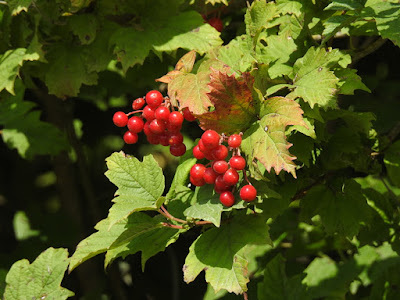The Nanoščica river basin is a nice example of an extensive agricultural landscape combined with wet meadows, hedges and woods. A lot of birds and other wildlife, including some rare and endangered species, benefit from such a mosaic landscape. There are several interesting butterflies in Slovenia that are typical for wet meadows and are endangered on an international level. One of them was the target of our recent trip to Nanoščica. We visited and searched several wet meadows in the area, before finding this amazing butterfly...
The Large Copper Lycaena dispar is a very rare butterfly in western Slovenia, confined to wet meadows and overgrown freshwater canals. We found only one specimen, the above male, which was sitting prominently on a very visible spot. Its orange upperwings probably serve as a territorial advertisement for other butterflies, that are also eagerly chased away.
Another butterfly dependent on wet meadows is the Scarce Large Blue Phengaris teleius that is quite frequent along the Nanoščica river. The season is a bit late for this species, but we nevertheless managed to see a few specimen (perched on their feeding plant: Sanguisorba officinalis).
Sooty Copper Lycaena tityrus was another species we found; it inhabits both wet and dry grasslands, as well as forest clearings. It is one of the commonest coppers in Slovenia.
The Tufted Marbled Skipper Carcharodus floccifera is scarce and locally distributed on wet meadows as well as dry grasslands in the Karst. We spotted just one or two of them.
Wet meadows at this time of year are not as colourful as in late spring, but fortunately there are some species that bloom late in the season too. Succisa pratensis is one of them, being a very common late-summer flower, sometimes covering entire meadows.
Gentiana pneumonanthe (marsh gentian) is another example of late-summer flower of wet meadows and acidic soils. It is also a feeding plant for the Alcon Blue Phengaris alcon, another rare butterfly confined to wet meadows.
Geranium palustre
Lycopus europaeus
Viburnum opulus
There are already many Red-backed Shrikes Lanius collurio on migration, although the above individuals were probably the local breeders - several noisy families were still around. The hedges and trees are now coming alive with passerine migrants like Pied Flycatcher Ficedula hypoleuca, Spotted Flycatcher Muscicapa striata, Wood Warbler Phylloscopus sibilatrix, Wryneck Jynx torquilla and others. In a bush by the Nanoščica river we also managed to get nice views of a migrant Grasshopper Warbler Locustella naevia, a bird we are not used to see so frequently.
Mount Nanos gave the name to the Nanoščica river, that flows in the valley under the mountain's eastern slopes (those that are visible in the photos). See this post for more about the Nanoščica river basin and this about Nanos.

















